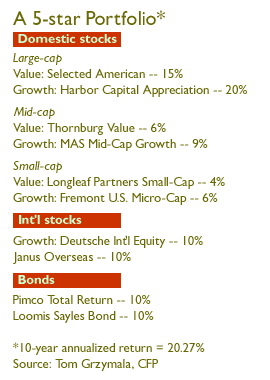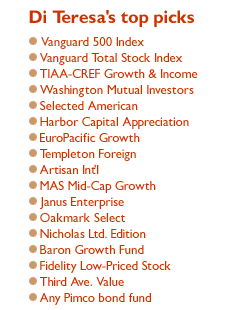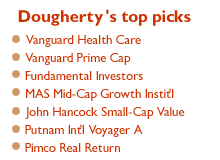|
Best funds for your 401(k)
|
 |
May 19, 2000: 8:01 a.m. ET
There's a world of choices, but choosing well can make a big difference
By Staff Writer Jeanne Sahadi
|
NEW YORK (CNNfn) - Having a 401(k) is great, but for some of us picking good funds is as hard as picking a good wine: The most you know is that it's red or white and comes in a bottle. Beyond that, you're lost.
CNNfn.com asked some financial planning and mutual fund experts to offer their top fund picks for a 401(k) with at least a 10-year time horizon.
Of course, no two plans will offer you the same choices. But if you're in a good plan, chances are at least some of the funds mentioned here will be available. And if they're not, you and your colleagues can always lobby your employer to add more to the mix.
Keep in mind, a few of the funds mentioned below have been closed to new investors, but if they are in your plan you should be able to get into them.
Achieving balance to beat S&P
Financial planner Tom Grzymala, whose firm Alexandria Financial Associates serves as investment adviser for 401(k) plans, designed a portfolio that carries about 80 percent of the volatility in the S&P 500 and outperformed the benchmark index over 10 years.
 With average growth of 20.3 percent a year for the past decade, a $10,000 investment in his portfolio would be worth more than $63,325 in pretax dollars today. With average growth of 20.3 percent a year for the past decade, a $10,000 investment in his portfolio would be worth more than $63,325 in pretax dollars today.
On a scale of 1 to 10, with 10 being the most aggressive, his portfolio ranks as a 6.5, Grzymala said.
Overall, he put 60 percent in domestic equities, 20 percent in international stocks and 20 percent in bonds.
He only included no-load funds that had returns in the top 30 percent of their categories for three years, seasoned managers and an expense ratio less than the mean among their peers.
Among Grzymala's top picks is the large-cap growth fund Harbor Capital Appreciation. Portfolio manager Spiros Segalas "has been there, done that and seen a lot come and go," he said. His expertise has brought the fund 10-year annualized returns of 25.4 percent, and 36 percent over the last year alone.
"The foremost foreign manager out there" is how Grzymala describes Helen Young Hayes, portfolio chief for Janus Overseas. "She does her homework," he said. And it shows. Investors in the fund have enjoyed a 30.8 percent average annual return for the past five years.
In the small-cap arena, Grzymala likes Fremont U.S. Micro-Cap. "That's a rocketer," he said, noting manager Robert E. Kern is "a tremendous individual" with a great track record. The fund has given investors an average annual return of 40.4 percent over the past five years.
Getting to the core
Peter Di Teresa, a senior analyst with fund-tracker Morningstar, believes 401(k) investors should have strong exposure to the broad U.S. market. "That should be the core of your portfolio. An index fund is an excellent way to go," he said.
That's why two Vanguard funds - Vanguard 500 Index and Vanguard Total Stock Index - are among his top picks.
 But so, too, is TIAA-CREF Growth & Income. "They do a good job combining indexing and active management," Di Teresa said. The fund has only been around since the fall of 1997, but it has matched or outperformed the S&P 500 since. But so, too, is TIAA-CREF Growth & Income. "They do a good job combining indexing and active management," Di Teresa said. The fund has only been around since the fall of 1997, but it has matched or outperformed the S&P 500 since.
Among large-cap funds, Di Teresa, like Grzymala, chose Harbor Capital Appreciation for growth and Selected American for value. But he also likes Washington Mutual Investors for value, despite the 5.75 percent front load, since such charges are often waived for 401(k) participants.
Among international funds, he favors EuroPacific Growth, which also has a load and is one of the biggest international funds around, he said. Its management team was among Morningstar's managers of the year in 1999 and was the top-performing fund of the decade in its category.
Check how your mutual funds are doing
For a less mainstream international choice, Di Teresa likes Templeton Foreign, which is a Morningstar Fund Analysts' Pick. He also favors Artisan International. Portfolio manager Mark Yockey also was honored as a 1999 manager of the year.
When it comes to small caps, Di Teresa chose the value-oriented Nicholas Limited Edition. "It's been a solid fund and tends to be less risky than some of its peers, but it gets competitive returns," he said.
Fidelity Low-Priced Stock, a small-cap value fund in Morningstar's 401(k) plan, got the nod despite its swollen asset size. "That should be a liability, but the manager (Joel C. Tillinghast) has done a skillful job," Di Teresa said, noting that when he asked other small-cap managers who they admire among their peers, they all named Tillinghast.
Defying the bears
Bill Dougherty, a fund analyst at Kanon Bloch Carre, took a slightly different approach than Grzymala and Di Teresa.
"It's important to have a fund with great long-term results, but I focused on funds that did better when the market declines," he said.
That is, he picked funds that tend to do better than their peers when bearish volatility rocks stocks.
 Among sector funds, he likes Vanguard Health Care, which has also been dubbed a long-term winner by Morningstar and one of the best 100 funds by Money magazine. In terms of resilient performance during downside volatility, "It's always in the top 10 percent," Dougherty said, noting that its returns put it in the top 20 percent of its peer group. Among sector funds, he likes Vanguard Health Care, which has also been dubbed a long-term winner by Morningstar and one of the best 100 funds by Money magazine. In terms of resilient performance during downside volatility, "It's always in the top 10 percent," Dougherty said, noting that its returns put it in the top 20 percent of its peer group.
But more than that, he said, "Health has long-term growth characteristics."
For large-cap growth, he favors Vanguard Prime Cap, which has been in the top quartile of its category for the past 10 years both in terms of returns and downside volatility.
Fundamental Investors gets his vote in the large-cap value category because its 10-year returns put the fund in the top 5 percent among its peers and the top 10 percent when it comes to a down market.
Read the latest fund news on CNNfn.com
Like Grzymala and Di Teresa, Dougherty strongly favors MAS Mid-Cap Growth Institutional. While it's a little riskier than his other picks -- it has only done better than 40 percent of funds in its category in a down market -- "the unit return you're getting is still very high (relative to its peers). Sometimes you have to take risk to make money," he said. On a 10-year annualized basis, MAS has returned 27.1 percent; its three-year return is 51.6 percent.
Internationally, he likes Putnam International Voyager, which is in the top 3 percent of its peer group in terms of three-year returns and performed in the top 10 percent of its category during two down markets in the fall of 1997 and summer of 1998. "By all means it's a blockbuster," he said.
As for bonds, Dougherty cautions investors about inflation. "For a 10-year or 20-year investor, inflation eats away at a bond fund," he said. That's why he recommends Pimco Real Return, because it invests in bonds that are adjusted for inflation.
But what if my plan is really bad?
If you're discouraged after reading this because your 401(k) has almost none of the funds mentioned, don't despair. First, there are other good funds out there. Secondly, whatever plan you have is tax-protected, which is a real plus, Di Teresa said. And if you get employer matches on top of that, think "free money" that shouldn't be passed up.
So invest anyway, experts advise. But be sure also to invest through other tax-protected vehicles like IRAs or Roths if the funds in your plan are too limited or less than stellar.
And if that is the case, keep your 401(k) investments simple, said certified financial planner Mari Adam. "Pick something that probably won't go wrong, like an S&P index fund," she suggested. "The lousier your plan gets, the simpler you get."
* Disclaimer 
|
|
|
|
|
 |

|

